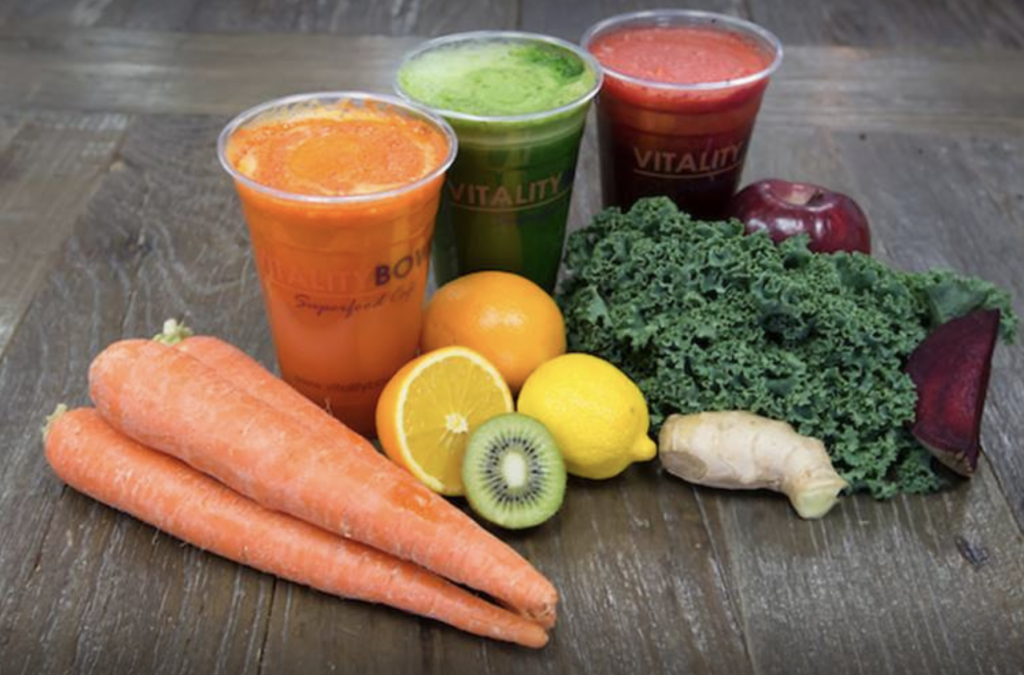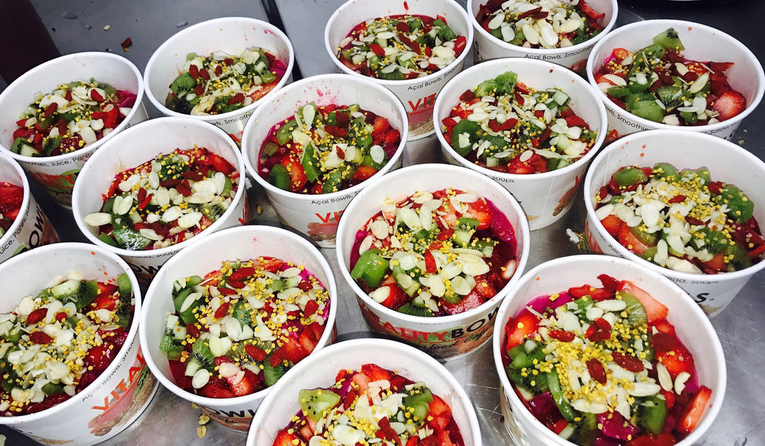
by thea@vitalitybowls.com | Oct 16, 2018 | Blog
BY THE HOUSTON CHRONICLE – A new superfood café is coming to the northwest Houston area.
Vitality Bowls, opening Oct. 25 at 24120 Northwest Freeway, Suite 250 in Cypress, has a focus on healthy superfoods including açaí bowls, smoothies, juices, paninis and salads.
The company was founded by Roy Gilad and Tara Gilad in California after discovering their daughter had severe food allergies, according to the press release.
The new location of the franchise, with more than 100 locations in the United States, will be owned by Jay Johnson and Susan Johnson. Susan Johnson said tasting the food made her want to own her own location.
“From the first bite I took from an açaí bowl at Vitality Bowls, I knew it was the start of a new journey for me,” said Susan Johnson in a press release. “The incredible taste of the fresh ingredients and the feeling it provides is just an unbeatable combination.”
The location will also include a full-service coffee bar with espresso and superfood drinks, as well as cold brew nitrogen-poured coffee and organic kombucha on tap. Tara Gilad said Vitality Bowls locations are meant to provide community members a healthier option.
“We believe that healthy food can be an option for fast casual food and we are excited to have Jay and Susan on board with this,” she said in the release. “We look forward to seeing the couple grow their business in Cypress and sharing the Vitality Bowls message with the community.”
by thea@vitalitybowls.com | Oct 10, 2018 | Blog
BY EATER ATLANTA – California-based Vitality Bowls Superfood Café is open at Alpharetta City Center on Commerce Street in the north metro Atlanta suburb. The fast-casual chain packs its menu full of what marketing gurus refer to as “superfoods” for “clean eating”: acai berries, dragonfruit, quinoa, and kale. The Alpharetta restaurant is owned locally by Paula Sauer.
Vitality Bowls, which claims to avoid cross contamination of ingredients in its sugar- and preservative-free kitchen, centers the menu around bowls using açaí berries. Bowls are then mixed with ingredients such as granola, hemp seeds, or bee pollen, along with much more obscure superfood fixings, including mangosteen (tropical fruit,) graviola (Brazilian paw paw,) and leaves from a moringa (a type of tree.) Vitality Bowls also offers soups, paninis, and salads as well as juices and smoothies.
“My husband Jeff and I are so happy to be part of this wonderful community,” Sauer says in the press release. “And we love being able to introduce Vitality Bowls healthy, clean eating to everyone.”
Atlantans are quite familiar with the superfood cafe model. Georgia-based Kale Me Crazy dominates the healthy, fast-casual restaurant market here. For those who love to eat clean while Instagramming, there’s also Westside’s Upbeet on Howell Mill Road and Flower Child in Sandy Springs (opening October 17) and at Shops Around Lenox in Buckhead.
Vitality Bowls has more than 50 locations across the U.S., including in Dunwoody and Midtown Atlanta.
Monday-Saturday, 8 a.m. to 8 p.m.; Sunday, 9 a.m. to 7 p.m.

by thea@vitalitybowls.com | Oct 10, 2018 | Blog
BY WHAT NOW ATLANTA – Vitality Bowls Superfood Café is now open in Alpharetta City Center, at 364 Commerce Street.
News of Vitality Bowls’ debut follows the opening of Anna Bella, a lingerie boutique, in the 26-area mixed-use development.
Chiringa, Natural Body, and Skin ReMedi also open Wednesday in Alpharetta City Center, a company spokesperson in an email told What Now Atlanta.
Locally owned by Paula Sauer, Vitality Bowls specializes in açaí bowls, a blend of açaí topped with organic granola and a selection of superfood ingredients such as bee pollen and hemp seed.
Other superfoods include the pitaya, or dragon fruit, as well as acerola, which is a cherry-sized tropical fruit, and graviola, which is often referred to as a blend between a strawberry and a pineapple.
Also on the menu are smoothies, juices, soups, salads, and paninis.
“My husband Jeff and I are so happy to be part of this wonderful community,” Sauer said in a press release Wednesday.
“And we love being able to introduce Vitality Bowls healthy, clean eating to everyone.”
Vitality Bowls Superfood Café is open Monday through Saturday, 8:00 a.m. to 8:00 p.m., and Sunday 9:00 a.m. to 7:00 p.m.
Additional Alpharetta City Center openings are expected through the next few weeks.

by thea@vitalitybowls.com | Oct 1, 2018 | Blog
BY QSR – In a world increasingly eating off premises, catering has become a vital strategy for limited-service restaurants.
Catering now represents nearly 10 percent of Vitality Bowls’ systemwide sales.
When East Coast natives Brad Bankos and Steve Wuench launched Eastcut Sandwich Bar in Durham, North Carolina, this past summer, the entrepreneurial duo had more on their minds than simply serving the guests who walked through the doors of their 50-seat establishment.
In fact, Bankos and Wuench designed their fast-casual concept with an eye on catering, looking to capitalize on the nearby presence of three major universities, a swelling corporate scene, and the local Research Triangle Park that hosts some 50,000 workers. Bankos and Wuench even selected their real estate for its large kitchen—a space that includes a dedicated prep area, refrigeration, and sinks for catering—and have strategically crafted a catering menu focused on portable, chef-driven items.
“We fully intend to make catering a big part of our business,” says Bankos, who foresees catering someday representing about 20 percent of the store’s revenue mix.
In the quick-service game, Eastcut isn’t alone in pursuing the catering bullseye.
With notable pioneers like Panera, Corner Bakery, and Jersey Mike’s showing what quick serves might accomplish beyond their restaurants’ four walls, the catering landscape continues to become more crowded and competitive—and that’s before you count the full-service caterers, full-service restaurants, and grocers that have long been engaged in the space and evolved their own programs to fight for dollars.
“Catering has been a secret sauce for some [quick-service] brands, but others have seen that success and jumped on the bandwagon to grab a piece of the pie,” says Jennifer Parker, cofounder of Impact Brands. The Dallas-based firm helps restaurants with strategic marketing and revenue growth, including the construction and refinement of catering programs.
To quick serves, catering’s appeal is clear: It’s a mechanism to spur trial and drive brand familiarity, an opportunity to heighten the restaurant’s marketplace penetration, and a chance to drive upward of 15–20 percent to the top line while incurring only incremental labor costs. Parker, in fact, calls catering “revenue gravy.”
“The flow-through to the bottom line and the brand can be significant and meaningful, and that’s why brands are putting a greater focus on catering than ever before,” Parker says.
Says Uriah Blum, cofounder of the 60-unit Vitality Bowls concept that has more aggressively prioritized catering over the last year: “The truth of the matter is that you can only get so many people into your doors. Catering broadens your reach in substantial ways.”
Attracted to catering’s promise, some quick serves have haphazardly entered the space and chased sales with mixed results. Others, however, have been strategic, investing in technology, sales teams, and operations to help ensure professional work and an optimal shot at success.
“Catering isn’t a fire-and-forget program,” Parker says. “There’s nuance involved, and it can be tough to get right.”
For those who execute savvy, calculated plans, she adds, there’s still business potential despite accelerating competition.
“The opportunity with catering remains massive, because convenience is driving everything, and that’s especially true for quick serves that can offer some impressive price points,” she says. “The sky’s the limit for those who do it well, while those who don’t will likely struggle to gain traction and remain mystified.”
With an eye on seizing success in the catering game now and in the years ahead, quick-service concepts across the country continue investigating the right recipe to drive catering results.
FAZOLI’S
Fazoli’s catering has been growing at a double-digit clip in recent years.
Unifying from top to bottom
From marketing and operations to R&D and HR, catering touches everybody in a restaurant business, and it’s important that leadership across the organization develops the processes necessary to ensure seamless operations.
“If you don’t have everybody on board, then it’s likely to be a flop,” Parker says.
Spurred by unified buy-in from Fazoli’s leadership that has trickled down throughout the business and into some 220 stores, catering at the Lexington, Kentucky–based chain has been growing at a double-digit clip in recent years. The chain has allocated various resources to build awareness of its catering program, evolved the menu, researched different packaging options, and invested in dedicated catering specialists at each restaurant.
“When our leadership really dug in and got the group moving together, we saw activity immediately,” says Jennifer Crawford, Fazoli’s director of off-premises sales.
Investing in people
As director of sales marketing at Zoës Kitchen from 2013 to 2016, Parker oversaw a catering program that grew from $10 million to $50 million in three years. She attributes that climb to a proactive sales team that “dialed for dollars” on phone calls, held tastings for corporate administrators, developed relationships with event organizers, and provided an otherwise hassle-free program.
“At the end of the day, this is a relationship business, and people like having a person there committed to making sure it all goes well,” Parker says.
It’s a model that others have adopted.
Earlier this year, Melt Shop, an 11-unit fast casual based in New York City, brought on a catering director tasked to develop relationships with local businesses and event venues and oversee operational excellence.
“It’s a sales role that also becomes operational in making sure that the food and experience are right,” Melt Shop founder and CEO Spencer Rubin says.
MELT SHOP
Earlier this year, Melt Shop brought on a catering director tasked to develop relationships with local businesses and event venues and oversee operational excellence.
Minimizing impact to operations
The beauty of catering is that restaurants can often get orders out the door before the rush of a specific daypart like lunch. But operators must be mindful of hustling to fill catering orders at the expense of their in-store business.
With that in mind, brands continue to investigate different ways to streamline catering and create seamless synergy between in-restaurant and off-premises dining. Some, like Eastcut, have invested in added kitchen space earmarked for catering, including off-site commissaries; others, like McAlister’s Deli, have incorporated dedicated in-store pickup spaces for catering orders, including drive-thru windows and curbside lanes.
“Catering cannot be detrimental to operations, and companies must look for creative ways that catering can exist side by side with the restaurant,” Parker says.
Solving the delivery piece
While third-party delivery services like Uber Eats and DoorDash have been a disruptive force in the restaurant game, using a third-party agency can be a challenging proposition for many quick-serve operators. Beyond the steep costs for these services, external delivery personnel become the face of a brand to a large group—and that can be unnerving.
That reality has pushed many to develop in-house delivery, where quality, reliability, and attention to detail can be better managed. This past summer, for instance, Slim Chickens, a 72-unit fast casual based in Fayetteville, Arkansas, unveiled in-house delivery for catering orders. Customers can place an order 24 hours in advance and pay a flat $15 delivery fee.
Though in-house delivery is an expensive proposition, especially with the additional labor and liability costs restaurants incur, it is also the best way for many brands to provide a professional, service-minded experience to this in-demand customer set.
“Delivery is the one thing that can make or break catering, because consumers, more than ever, want turnkey options,” Parker says.
Leveraging tech
To perhaps no one’s surprise, technology is playing a prominent and escalating role in catering. Those who can harness technological tools like online ordering and loyalty programs are better positioned to succeed.
With that in mind, sandwich chain Capriotti’s is updating its online ordering experience with a substantial focus on minimizing friction for the end user. The 100-unit chain is also adjusting its rewards program to provide “points” on money spent as opposed to visits.
“It’s all an effort to entice ongoing traffic and benefit our customers,” says Capriotti’s senior vice president of marketing Jane McPherson.
EASTCUT SANDWICH BAR
Eastcut was designed with an eye on catering, looking to capitalize on the nearby presence of three major universities.
Looking for white space
With its health-centric messaging and a menu featuring açaí bowls and smoothies, Vitality Bowls has found a niche in the breakfast daypart and with snacking that many other quick serves are not as well positioned to capture. Catering now represents nearly 10 percent of Vitality Bowls’ systemwide sales, and Blum feels that number will approach 20 percent in the coming years with some continued work and refinement.
“We now have offices getting breakfast from us on a weekly basis,” Blum says. “We’ve found a niche, and we’re running with it.”
As many quick serves battle for corporate lunches or social catering business like birthday or graduation parties, there remains enticing white space all around the catering landscape. From morning tailgates to Sweet 16 parties, teacher appreciation days to early sales meetings, opportunities abound for those who craft the right message and deliver the right product.
Continuing investment
Among its quick-service brethren, Panera made early inroads into catering with significant and intentional investments in technology, delivery, and marketing. The company set catering as a priority, built its base, and has continued to refine its program and score impressive gains. It’s a lesson, Parker says, for other brands.
“If you do it, then you need to do it,” she says.
To that end, Melt Shop recently debuted a fully insulated catering box that uses existing heat in the lower compartment to heat sandwiches in the upper compartment. That effort, Rubin says, helps Melt Shop restaurants deliver “the best hot, steamy sandwich possible.” The upstart chain has also invested in R&D to explore new menu items, tested various delivery formats, and purchased equipment that allows staff to create an on-site “mini-kitchen” at different events.
Vitality Bowls, meanwhile, acquired equipment that has allowed staff to blend up to 20 açaí bowls at one time, invested heavily in targeted advertising (both digital and traditional), and cultivated strategic partnerships with platforms such as ezCater and Waiter.com that help offices find catering solutions.
“Make investments now to build a solid foundation, but know success in catering is an ongoing process that requires work on better packaging, better delivery, scalability, investing in the right people, and so much more,” Parker says.




Recent Comments